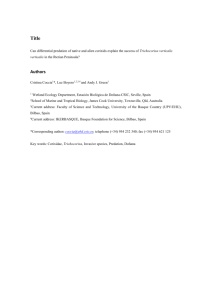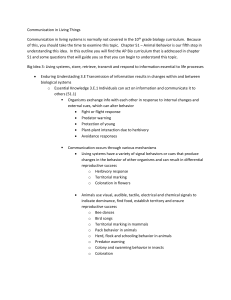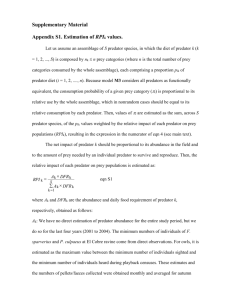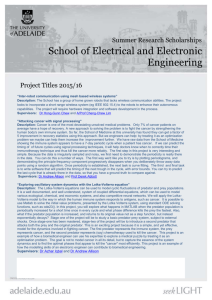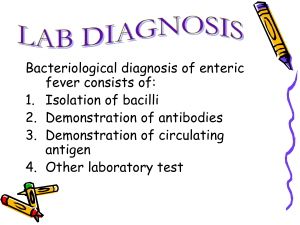1. Methods - Proceedings of the Royal Society B
advertisement
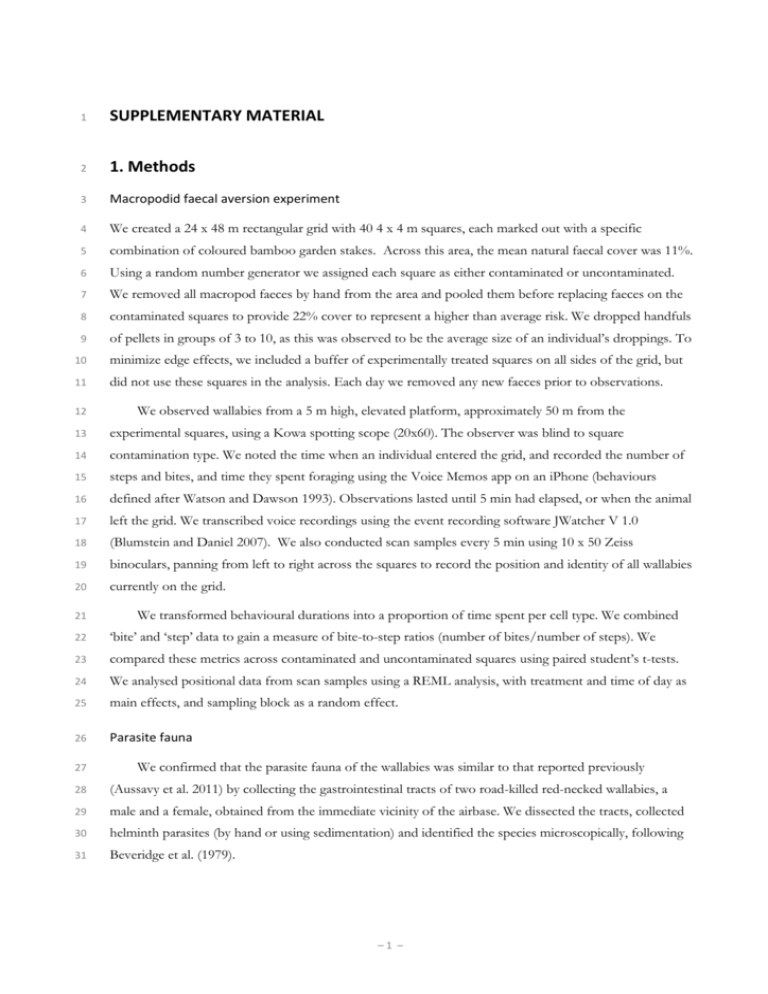
1 SUPPLEMENTARY MATERIAL 2 1. Methods 3 Macropodid faecal aversion experiment 4 We created a 24 x 48 m rectangular grid with 40 4 x 4 m squares, each marked out with a specific 5 combination of coloured bamboo garden stakes. Across this area, the mean natural faecal cover was 11%. 6 Using a random number generator we assigned each square as either contaminated or uncontaminated. 7 We removed all macropod faeces by hand from the area and pooled them before replacing faeces on the 8 contaminated squares to provide 22% cover to represent a higher than average risk. We dropped handfuls 9 of pellets in groups of 3 to 10, as this was observed to be the average size of an individual’s droppings. To 10 minimize edge effects, we included a buffer of experimentally treated squares on all sides of the grid, but 11 did not use these squares in the analysis. Each day we removed any new faeces prior to observations. 12 We observed wallabies from a 5 m high, elevated platform, approximately 50 m from the 13 experimental squares, using a Kowa spotting scope (20x60). The observer was blind to square 14 contamination type. We noted the time when an individual entered the grid, and recorded the number of 15 steps and bites, and time they spent foraging using the Voice Memos app on an iPhone (behaviours 16 defined after Watson and Dawson 1993). Observations lasted until 5 min had elapsed, or when the animal 17 left the grid. We transcribed voice recordings using the event recording software JWatcher V 1.0 18 (Blumstein and Daniel 2007). We also conducted scan samples every 5 min using 10 x 50 Zeiss 19 binoculars, panning from left to right across the squares to record the position and identity of all wallabies 20 currently on the grid. 21 We transformed behavioural durations into a proportion of time spent per cell type. We combined 22 ‘bite’ and ‘step’ data to gain a measure of bite-to-step ratios (number of bites/number of steps). We 23 compared these metrics across contaminated and uncontaminated squares using paired student’s t-tests. 24 We analysed positional data from scan samples using a REML analysis, with treatment and time of day as 25 main effects, and sampling block as a random effect. 26 Parasite fauna 27 We confirmed that the parasite fauna of the wallabies was similar to that reported previously 28 (Aussavy et al. 2011) by collecting the gastrointestinal tracts of two road-killed red-necked wallabies, a 29 male and a female, obtained from the immediate vicinity of the airbase. We dissected the tracts, collected 30 helminth parasites (by hand or using sedimentation) and identified the species microscopically, following 31 Beveridge et al. (1979). –1 – 32 2. RESULTS 33 Macropodid faecal aversion 34 Wallabies were recorded more frequently in uncontaminated squares than in contaminated squares (F1, 35 270 = 154.5, p < 0.0001) and stayed significantly longer in uncontaminated (214 11 s) than 36 contaminated (51 9 s; F1, 141 = 10.5, p < 0.0001) squares. Wallabies took over 30 times more bites per 37 step in uncontaminated squares (9.1 ± 1.7) than in contaminated squares (0.3 ± 0.1; t141 = 3.38, p < 38 0.001). 39 Parasite fauna 40 Combined, the studies reveal considerable diversity of gastrointestinal parasite populations both between 41 and among the different locations of the gastrointestinal tract (see table S1). Yet despite this diversity, 42 remarkably only two parasite species are reported in both red-necked wallabies and grey kangaroos: 43 Globocephaloides trifidospicularis and Austrostongylus macropodis, both occurring in the small intestine. We 44 identified fewer species of gastrointestinal parasites than Aussavy et al (2011), with four species common 45 to both studies. 46 Experiments 47 Statistical models exploring the variation in foraging behaviour in the faecal aversion experiment and the 48 combined faecal aversion experiments are given in Table S2, and Table S3 respectively. 49 References 50 Aussavy M, Bernardin E, Corrigan A, Hufschmid J, Beveridge I. 2011 Helminth parasite communities in four 51 52 53 species of sympatric macropodids in western Victoria. Australian Mammalogy 33, 13-20. Beveridge I, Arundel JH. 1979 Helminth parasites of grey kangaroos, Macropus giganteus Shaw and M. fuliginosus (Desmarest), in Eastern Australia. Wildlife Research 6, 69–77. 54 Blumstein DT, Daniel JC. 2007 Quantifying behavior the JWatcher way. Sinauer Associates Inc. 55 Watson DM, Dawson TJ. 1993 The effects of age, sex, reproductive status and temporal factors on the time use 56 of free ranging red kangaroos. Wildlife Research 20, 785–801. –2 – 57 58 59 60 61 62 Table S1. The gastrointestinal fauna found in two red-necked wallabies (Macropus rufogriseus) from the Victoria valley airbase in the Grampians National Park compared to those found by Aussavy et al. (2011) in wallabies and western and eastern grey kangaroos (M. giganteus and M. fuliginosus) from the surrounding areas. Gastrointestinal location of parasites Parasites identified in the present study Parasites identified by Aussavy et al. 2011 Macropus rufogriseus M. rufogriseus M. fuliginosus and M. giganteus Cyclostrongylus alatus Cy. perplexus Filarinema asymmetricum Labiosimplex australis Pararugopharynx protemnodontis Rugopharynx epsilon R. spratti R. longibursaris Wallabinema australe W. labiatum Cyclostrongylus wallabiae Not investigated Cloacina annulata C. castor C. edwardsi C. eos C. littoralis C. mawsonae C. papillata C. pollux C. sp. nov. C. wallabiae Filarinema asymmetricum Macropostrongyloides dissimilis Parazoniolaimus collaris Rugopharynx epsilon R. mu Wallabinema australe Small Intestine Austrostongylus chandleri A. macropodis A. smalesae A. wallabiae Large Intestine Hypodontus macropi Austrostrongylus victoriensis Globocephaloides trifidospicularis Progamotaenia macropodis P. ualabati Triplotaenia undosa Hypodontus macropi Alocostoma clelandi Cloacina artemis C. expansa C. hera C. herceus C. hermes C. obtusa C. pelops C. selene L. kungi L. laterilabellosus L. major Labiosimplex bipapillosus Labiosimplex spp. Paramacropostrongylus typicus Pharyngostrongylus kappa Popovastrongylus pearsoni Rugopharynx macropodis R. rosemariae Austrostrongylus chandleri A. macropodis Austrostrongylus sp. nov. Globocephaloides trifidospicularis Oesophagus Stomach –3 – Macropostrongyloides baylisi Macropostr. yamagutii Macropoxyuris brevigularis Macropox. longigularis Macropox. spp. Table S2. REML models explaining variation in the foraging behavour of wallabies in the predator faecal aversion experiment. The reported reduced models are derived by sequentially removing non-significant (p > 0.1) interaction terms from the original full factorial model. Estimate a) Log (Approach time) (r2 = 0.86, n = 97) Parameter Estimates Term Intercept Predator faeces [Control] Predator faeces [Kangaroo] Predator faeces [Possum] Predator faeces [Rabbit] Predator faeces [Sheep] Fixed Effects Tests Main effects Predator faeces [control, wallaby, kangaroo, sheep, possum, rabbit] Time of day [morning, afternoon] Distance from cover 3.328 -2.314 1.222 -0.164 -0.285 0.207 SE 0.124 0.117 0.121 0.122 0.125 0.127 df Statistics P t Ratio > |t| 20.4 88.8 88.9 89.0 87.9 87.2 26.86 -19.83 10.14 -1.35 -2.28 1.62 < 0.0001 < 0.0001 < 0.0001 0.18 0.0252 0.11 86.8 F ratio 106.2 >F < 0.001 88.4 54.5 0.141 0.531 0.71 0.47 t Ratio > |t| 24.7 83.5 83.88 83.98 77.4 82.65 7.71 -5.37 3.37 0.33 -0.67 1.00 < 0.0001 < 0.0001 0.0011 0.7415 0.5024 0.3201 81.9 F ratio 7.340 >F < 0.001 83.6 58.2 0.048 2.532 0.83 0.12 82.4 2.643 0.0288 t Ratio > |t| 51.5 81.7 83.7 81.7 83.5 81.8 9.64 9.32 -4.78 0.69 1.42 -0.71 < 0.0001 < 0.0001 < 0.0001 0.4935 0.1584 0.4768 81.8 F ratio 24.484 >F < 0.001 83.4 82.7 2.485 0.413 0.12 0.52 82.5 2.488 0.0379 b) Vigilance time (r2 = 0.41, n = 97) Parameter Estimates Term Intercept Predator faeces [Control] Predator faeces [Kangaroo] Predator faeces [Possum] Predator faeces [Rabbit] Predator faeces [Sheep] Predator faeces x distance from cover Fixed Effects Tests Main effects Predator faeces [control, wallaby, kangaroo, sheep, possum, rabbit] Time of day [morning, afternoon] Distance from cover Interaction Predator faeces x distance from cover 1.643 -1.079 0.707 0.069 -0.165 0.222 Included 0.213 0.201 0.210 0.208 0.245 0.222 c) Amount eaten (r2 = 0.67, n = 97) Parameter Estimates Term Intercept Predator faeces [Control] Predator faeces [Kangaroo] Predator faeces [Possum] Predator faeces [Rabbit] Predator faeces [Sheep] Predator faeces x Time of day Fixed Effects Tests Main effects Predator faeces [control, wallaby, kangaroo, sheep, possum, rabbit] Time of day [morning, afternoon] Distance from cover Interaction Predator faeces x Time of day 61.293 52.998 -28.186 4.025 8.997 -4.731 Included –4 – 6.356 5.684 5.900 5.851 6.322 6.620 Table S3. REML models explaining variation in the foraging behavour of wallabies in the combined predator and herbivore faecal aversion experiment. The reported reduced models are derived by sequentially removing non-significant (p > 0.1) interaction terms from the original full factorial model. Estimate a) Log (Approach time) (r2 = 0.51, n = 68) Parameter Estimates Term Intercept Predator faeces [kangaroo] Predator faeces [possum] Parasite [kangaroo] Predator faeces x Parasite x Time of day Parasite x Distance from cover x Time of day 3.402 0.311 -0.610 -0.084 Included Included SE 0.151 0.070 0.065 0.047 Fixed Effects Tests Main effects Predator faeces [wallaby, kangaroo, possum] Parasite [wallaby, kangaroo] Time of day [morning, evening] Distance from cover Interaction Predator faeces x Parasite x Time of day Parasite x Distance from cover x Time of day df Statistics P t Ratio > |t| 48.8 58.5 58.5 58.6 22.58 4.42 -9.34 -1.81 < 0.0001 < 0.0001 < 0.0001 0.08 57.1 58.6 59.0 58.3 F ratio 43.85 3.272 1.210 0.180 >F < 0.0001 0.08 0.28 0.67 52.1 58.2 7.858 5.260 0.0010 0.0255 t Ratio > |t| 58.7 60.0 59.7 59.4 5.31 3.55 -3.56 3.77 < 0.0001 0.0008 < 0.0007 0.0004 58.1 59.4 59.6 58.4 F ratio 8.085 14.230 0.452 3.990 >F 0.0008 0.0004 0.50 0.0504 59.1 8.638 0.0005 t Ratio > |t| 58.0 62.0 60.4 61.7 60.2 3.09 0.32 2.73 5.31 2.06 0.0030 0.75 0.0082 < 0.0001 0.0434 59.2 61.7 61.0 60.2 F ratio 5.742 28.196 1.747 4.257 >F 0.005 < 0.001 0.19 0.0434 b) Log (Vigilance time) (r2 = 0.57, n = 61) Parameter Estimates Term Intercept Predator faeces [kangaroo] Predator faeces [possum] Parasite [kangaroo] Predator faeces x Parasite x Distance from cover 1.559 0.518 -0.499 0.358 Included 0.293 0.146 0.140 0.095 Fixed Effects Tests Main effects Predator faeces [wallaby, kangaroo, possum] Parasite [wallaby, kangaroo] Time of day [morning, evening] Distance from cover Interaction Predator faeces x Parasite x Distance from cover c) Amount eaten (r2 = 0.46, n = 68) Parameter Estimates Term Intercept Predator faeces type [kangaroo] Predator faeces type [possum] Parasite [kangaroo] Distance from cover Fixed Effects Tests Main effects Predator faeces [wallaby, kangaroo, possum] Parasite [kangaroo, wallaby] Time of day [morning, evening] Distance from cover 36.823 1.779 14.725 20.819 1.076 –5 – 11.904 5.564 5.388 3.921 0.522

